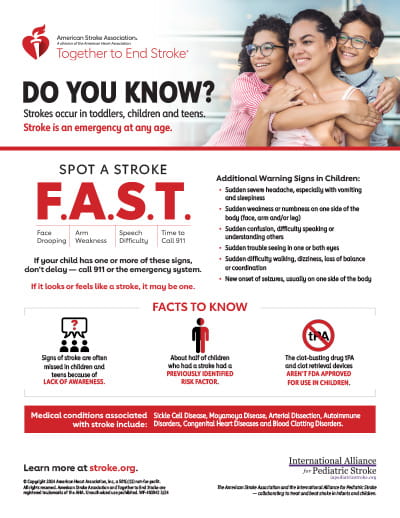Pediatric Stroke Infographic
 American Stroke Association
American Stroke Association
Together to End Stroke®
Do you know?
Strokes occur in toddlers, children and teens.
Stroke is an emergency at any age.
Spot a Stroke F.A.S.T.
- F - Face Drooping
- A - Arm Weakness
- S - Speech Difficulty
- T - Time to Call 911
If your child has one or more of these signs, don’t delay — call 911 or the emergency system.
If it looks or feels like a stroke, it may be one.
Additional Warning Signs in Children:
- Sudden severe headache, especially with vomiting and sleepiness
- Sudden weakness or numbness on one side of the body (face, arm and/or leg)
- Sudden confusion, difficulty speaking or understanding others
- Sudden trouble seeing in one or both eyes
- Sudden difficulty walking, dizziness, loss of balance or coordination
- New onset of seizures, usually on one side of the body
Facts to Know
- Signs of stroke are often missed in children and teens because of lack of awareness.
- About half of children who had a stroke had a previously identified risk factor.
- The clot-busting drug tPA and clot retrieval devices aren’t FDA approved for use in children.
Medical conditions associated with stroke include:
Sickle Cell Disease, Moyamoya Disease, Arterial Dissection, Autoimmune Disorders, Congenital Heart Diseases and Blood Clotting Disorders.
International Alliance for Pediatric Stroke
The American Stroke Association and the International Alliance for Pediatric Stroke — collaborating to treat and beat stroke in infants and children.
© Copyright 2024 American Heart Association, Inc, a 501(c)(3) not-for-profit. All rights reserved. American Stroke Association and Together to End Stroke are registered trademarks of the AHA. Unauthorized use prohibited. WF-463942 3/24